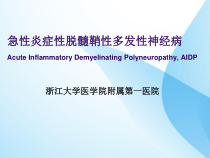 PPT
PPT
【文档说明】急性炎症性脱髓鞘性-多发性神经病课件.ppt,共(49)页,1.893 MB,由小橙橙上传
转载请保留链接:https://www.ichengzhen.cn/view-243729.html
以下为本文档部分文字说明:
急性炎症性脱髓鞘性多发性神经病AcuteInflammatoryDemyelinatingPolyneuropathy,AIDP浙江大学医学院附属第一医院Introduction⚫Landry-Landry'sparalysis1859⚫Landryreportedanacute
,ascending,predominantlymotorparalysiswithrespiratoryfailure,leadingtodeath⚫Guillair-Barre19162例⚫Guillain,Barreandstrohl(1916)
reportedabenignpolyneuritiswithalbuminocytologicdissociationintheCSF(raisedconcentrationofCSFproteinbutanormalcellcount)蛋白细胞分离是本病的特征GuillainBarre
LandryStrohlIntroduction⚫In1956,CMillerFisherdescribedatriadofacuteophthalmoplegia,ataxia,andareflexia,n
owknownasFisher’ssyndrome⚫Duringthepast15years,GBShasbecomeclearthatthisclinicalpicture,nowcalledGuillai
n-Barrésyndrome,andhavedifferentpathologicalsubtypesEpidemiology⚫Worldwideincidence⚫0.6-4/100000peryearthroughouttheworld⚫Chinaincidence⚫0.66per1000
00forallages⚫可发生于任何年龄,男女发病率相似,夏秋多见临床表现:中国⚫儿童和青少年,夏初。⚫EMG:轴索损害,AMAN。⚫EMG符合AMAN的为65%,符合AIDP的为24%。⚫66%有CJ抗体,42%有GM1抗体
,其他神经节苷脂抗体为17-26%。与西方国家不同,GM1抗体与AMAN或AIDP无关。近来发现AMAN与GD1a抗体相关密切。临床表现:中国⚫病理:⚫AMAN:IgG和补体在轴索周围沉积,巨噬细胞侵入轴索周围间隙,严
重者有轴索变性。⚫AIDP:IgG和补体在髓鞘外沉积,巨噬细胞也在髓鞘外,“撕开”髓鞘。⚫AMSAN:感觉轴索比运动轴索损害重。⚫EMG不能预测病理。PathogenesisandPathophysio
logy⚫Thecauseofthissyndromeisunknown,butitisgenerallyviewedtobeanautoimmuneresponsetoabacterialorviralinfection.⚫病因尚未完全阐明Etiology⚫Camp
ylobacterJejuni⚫Epstein-BarrVirus(EBV)⚫Cytomegalovirus(CMV)⚫HIV⚫Vaccinations⚫···········空肠肠弯曲菌PathogenesisandPathophysiology⚫Anacuteimmune-media
tedpolyneuropathy,componentofpathogenwassimilarwithmyelinsheathofperipheralnerve⚫与感染有关的自身免疫性疾病,病原体某些成分与周围神经的髓鞘成分相似Pathophysiology⚫主要病理特点(princ
ipalcharacteristicofpathology)⚫节段性脱髓鞘(segmentaldemyelization)⚫小血管周围炎性细胞浸润Clinicalmanifestations⚫多数患者
有前驱症状(起病前1~3周)⚫呼吸道感染症状⚫喉痛、鼻塞、发热⚫消化道症状⚫腹泻、呕吐Clinicalmanifestations⚫Progressiveascendingsymmetricalweaknessofthelimbs⚫Involvementofproxim
alanddistalmuscles⚫Numbnessandtinglinginthehandsandfeet⚫BackpainClinicalmanifestations⚫Depressedorabsentreflexes⚫Involvem
entofcranialnerves(facialnervesmostcommonlyinvolved)⚫Respiratoryfailure(involvedrespiratorymuscles)⚫Progressiontopeakdisabilityin4wk⚫autonomicnerves
ymptomAssessment⚫Cerebrospinalfluid⚫Increasedproteinusuallyafter7to10days.⚫Whilesomeproteinisnormallypresent,ani
ncreasedamountwithoutanincreaseinthenumberofwhitebloodcellsmayindicateGBS⚫蛋白细胞分离Assessment⚫Nerveconductionveloc
itytest⚫NerveconductionstudiesareadependableandearlydiagnosticindicatorofGBS.⚫showsdemyelizationanddamagetothenerv
esheath⚫F反应、H反射异常PL延长,NCV减慢⚫传导阻滞现象,伴或不伴有波幅降低Assessment⚫腓肠神经活检⚫节段性脱髓鞘⚫小血管周围炎性细胞浸润⚫Electrocardiogram(EKG)⚫Mayshowabnormalitiesincardiacrhythm⚫心律失
常SubtypesofGBS⚫经典型AIDP⚫Fisher综合症(MillerFishersyndrome):⚫三联征-“眼外肌麻痹、共济失调、腱反射消失”,还有中枢神经系统损害⚫Itwasthoughttobea
variantofGBSandcomprisecompleteophthalmoplegiawithataxiaandareflexia⚫脑神经型SubtypesofGBS⚫轴突型⚫纯运动型(AMAN)⚫运动感觉型(AMSAN)⚫急性感觉性多发性神经炎(ASP
)⚫急性全自主神经病(APN)⚫假性肌营养不良⚫复发型Diagnosis⚫Requiredfordiagnosis⚫Progressiveweaknessofoneormorelimb⚫Distalare
flexiawithproximalareflexiaorhyporeflexiaDiagnosis⚫Supportivediagnosis⚫Progressionofsymptomsoverdaysto4wk⚫Relativesymmetryofdeficits⚫Mildsensoryinvo
lvement⚫Cranialnerveinvolvement(especiallyVII)⚫Recoverybeginningwithin4wkDiagnosis⚫Supportivediagnosis⚫Autonomicd
ysfunction⚫Nofever⚫IncreasedCSFproteinafter1wk⚫CSFwhitebloodcellcount≤10/μL⚫Nerveconductionslowingorblock
edbyseveralweeksDiagnosis⚫Againstdiagnosis⚫Significantasymmetricweakness⚫Bowelorbladderdysfunctionatonsetorpersisten
t⚫CSFwhitebloodcellcount>50orPMNcount>0μL⚫Well-demarcatedsensorylevelDiagnosis⚫Excludingdiagnosis⚫Isolatedsensoryinvolvement,withoutweakness⚫Anot
herpolyneuropathythatexplainsclinicalpictureDifferentialdiagnosis⚫Acquiredhypokalemia⚫Botulism⚫Myastheniagravis⚫Periodicparalys
is⚫Poliomyelitis⚫Polymyositis⚫Tickparalysis⚫Diphtheria⚫Transversemyelitis⚫Heavymetal(leadandarsenicpoisoning)Differentialdiagnosis⚫低钾性周期性瘫痪
(hypokalemicperiodicparalysis)⚫无病前感染史,常有发作史⚫无感觉和脑神经损害,脑脊液正常⚫电解质(血钾<3.5)及心电图检查异常⚫补钾治疗有效Differentialdiagnosis⚫重症肌无力(myastheniagravis)⚫骨骼肌病态易疲劳
性、波动性⚫nosensorysymptoms⚫tendonreflexesareunimpairedDifferentialdiagnosis⚫脊髓灰质炎(poliomyelitis)⚫早期出现括约肌功能障碍⚫无感觉障碍⚫Fever,meningealsymptoms,early
pleocytosis,andpurelymotorandusuallyasymmetricalareflexicparalysis.Differentialdiagnosis⚫急性脊髓炎(acutemyelitis)⚫Theimmediateproblemist
odifferentiateGBSfromacutespinalcorddisease(markedbysensorimotorparalysisbelowalevelonthetrunkandsphinctericparalysis).
Clinicalmanagement⚫Generaltreatment一般治疗⚫Immunotherapy免疫治疗Generaltreatment⚫保持呼吸道通畅⚫辅助呼吸⚫密切观察,测肺活量20ml/kg→ICU必要时气管插管,使用呼吸器⚫预防呼吸道感染⚫翻身、拍背、稀化痰液、吸痰Ge
neraltreatment⚫预防并发症(preventionofcomplication)⚫坠积性肺炎⚫褥疮⚫血栓性静脉炎⚫防止肢体挛缩⚫尿路感染Generaltreatment⚫预防并发症(preventionofcomplication)⚫合
理的正压通气、吸出分泌物⚫经常翻身,保持床单平整⚫皮下应用肝素⚫有临床指征时,应用广谱抗生素等Generaltreatment⚫对症处理⚫必要时心电监护⚫高血压—小剂量β受体阻滞剂⚫低血压—补液⚫心动过速—通常不需要治疗⚫心动过缓
—阿托品⚫疼痛—卡马西平Immunotherapy⚫机理⚫抑制免疫反应,去除致病因子对神经损害,使髓鞘有时间再生⚫方法⚫血浆置换⚫静脉注射免疫球蛋白⚫皮质醇激素治疗Plasmaexchange⚫Theus
efulnessofplasmaexchangeintheevolvingphaseofGBS.⚫Inpatientswhoaretreatedwithin2weeksofonset,thereisareductionintheperiodofh
ospitalizationinthelengthoftimethatthepatientrequiresmechanicalventilation.⚫However,whenplasmaexchangeisdelayedfor2weeksor
longeraftertheonsetofthedisease,theprocedurehas,withafewnotableexceptions,beenoflittlevalue.Plasmaexchan
ge⚫血浆置换⚫机制:去除血浆中致病因子,可明显缩短病程,使用越早,疗效越好,⚫专用设备,价格昂贵⚫适用于急性进行性加重的GBS⚫用法:40ml/kg⚫禁忌症:严重感染,心律失常、心功能不全,凝血功能障碍Intravenousimmunoglobulin⚫静脉注射免
疫球蛋白⚫尽早施行⚫用法:0.4g/(kg.d)×5天⚫禁忌症:免疫球蛋白过敏,先天性IgA缺乏⚫PE和IVIG不必联合应用Corticosteroids⚫皮质类固醇⚫有争议⚫理论上合理⚫研究表明无效⚫经验:青年人大剂量早期使用Corticosteroids⚫Theval
ueofcorticosteroidsinthetreatmentofGBShasbeendisputedfordecades.⚫AlthoughcorticosteroidscannolongerrecommendedasroutinetreatmentforacuteGBS.⚫Wehaveo
bservedafewinstancesinwhichtheintravenousadministrationwithhigh-closecorticosteroidsseeminglyhaltedt
heprogressofthedisease.Prognosis⚫Prognosis⚫Themajorityofpatientsrecovercompletelyornearlycompletely⚫Inabout10percentofpatients,theresidua
ldisabilityispronounced预后⚫80%患者恢复完全⚫死亡率大约5%(呼吸肌麻痹)
 辽公网安备 21102102000191号
辽公网安备 21102102000191号
 营业执照
营业执照